
10 minute read
WHS AND THE CHALLENGES OF COVID-19
WHS AND THE CHALLENGES
OF COVID-19
Advertisement
By Martin Roberts
By a strange coincidence, the last task I performed before leaving the school site for the lockdown in March 2020 was to take delivery of a pallet of some 500 copies of “The House on the Hill”, the history of Winchester House. As I drove home, I reflected on how little the school archives had contained about the human details of world-changing events and their effects on school life. Wartime WHS, for example, still lived in the memories of those who had been pupils at the time, but no-one had written a contemporary account of either World War from the point of view of how the school had changed. Similarly, the great Spanish Flu pandemic of the immediate post World War One years is scarcely mentioned. So, for the benefit of future generations, here is an attempt to relate how Covid-19 came upon us in the spring of 2020.
Winchester House School has, over the years, been no stranger to outbreaks of infectious illness, which were often much more serious in the days before antibiotics were developed. Molly, the daughter of Headmaster Leachman, had nearly died in one such outbreak and the school had been closed on other occasions and the pupils sent home to try to halt the spread of infection. This had usually worked well, but the evidence of letters of condolence written to parents by Headmaster Hayman shows that childhood mortality was far from defeated. In more modern times, the spread of so-called “Asian Flu” in the late 1950s and “Hong Kong Flu” a decade later left WHS relatively unmolested and the possibility of a serious health issue arising was, if not discounted, at least not particularly anticipated. In 2004, as Director of Studies, Margaret Marsh incorporated planning for the possibility of an outbreak of SARS into a pre-term training day. Staff were encouraged to consider how lessons would be given in the event and emphasis was placed on preparation using laptops. Departments drew up plans but providentially SARS went away (permanently, one hopes) and our world continued to turn.
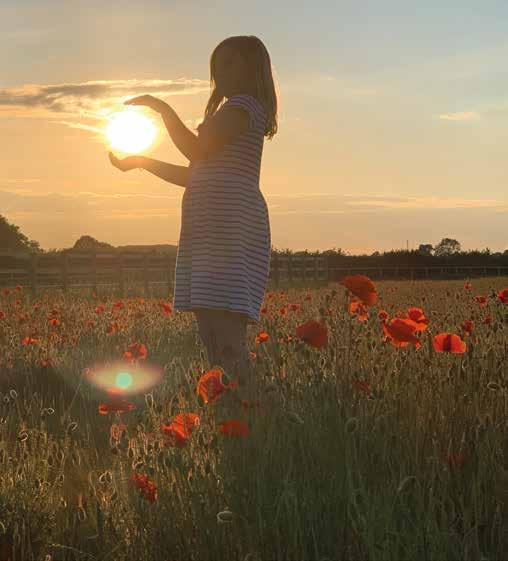
Left: Orla (Year 5).
One of the lockdown topics challenged the children to create optical illusion photographs within nature or using objects.
So the sporadic news in early 2020 of a strange virus circulating in the live markets of Wuhan and spreading into the community caused concern but did not seem to call for emergency measures. However, the effects of globalisation quickly provided a conduit for the virus to spread rapidly and the equally globalised media published accounts of the drastic measures being taken by the Chinese government to suppress it. A few cases were reported in the UK, worryingly, but it was not until half-term in February that the hotspot in Northern Italy became the source of a major European infection. There was obviously concern for pupils whose families lived in affected countries and for those who had travelled on winter sports holidays, some of whom had had narrow escapes from dangerous areas. Furthermore, wide coverage was given in the press to outbreaks of so-called coronavirus. A local health centre was temporarily closed for deep cleaning by workers in white hazmat suits; local surgeries displayed warnings not to enter to those with certain symptoms; care homes began to batten down their hatches.
The rising tide of infection, the unavailability of either vaccine or effective treatment and the uncertainty of the future trajectory of the disease led those with responsibility for the welfare of Winchester House to take counsel. The particular expertise of individual governors was a great asset, as was the calm professionalism of those who worked at the school in all capacities. A huge amount of planning, training and general preparation preceded the closure of the school site a week before the end of Lent Term 2020. Initially, it was hoped that this lockdown would be short-lived, but the imposition of a national lockdown meant that no children would attend school physically until almost the second half of Summer Term.
For the children, the changes in daily routine were remarkable. All learning was done from home with subjects separated into core and enrichment. The core subjects were mainly taught in the morning, following registration, and Google Classroom was the means of delivery, following an intense period of transition overseen by the tireless efforts of Chris Leach, Head of IT, and Simon Robinson, Computer Technician. The enrichment subjects were dealt with by the specialist staff and were designed to provide for those educational needs beyond the core subjects, ranging from Classical Greek to Art and Design. Sadly, many games were not possible in the traditional sense under the strict lockdown conditions.
Freya (Year 6), (below); Angus (Year 5) with Bert (below right).
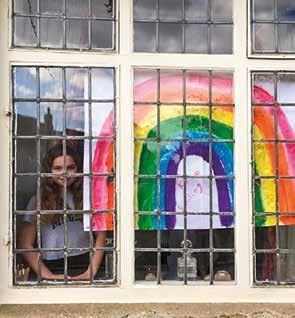
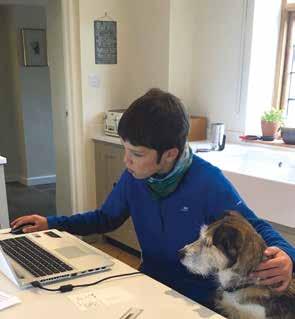
Some very impressive and imaginative work was produced, especially in the creative arts, with a very successful repurposing project which took redundant everyday objects and gave them new identities. There was a lot of parental support and much attention was devoted to the well-being of those who found this new way of living stressful. Tutors and Heads of Departments found liaison with parents gave an insight into the daily life of twenty-first century children as never before. That all this worked was ultimately shown in the excellent Common Entrance results; all passed into their chosen schools.
A glance at the WHS Instagram account (winchesterhouseschool) will show just how many imaginative feats were achieved by individuals selfisolating or locked-down. The Year 8 cohort responded to the shortage of lavatory paper caused by panic buying by producing a video in which each individual in sequence caught a roll thrown from off-screen, did something amusing with it and then threw it off-screen to the next participant, all to the strains of “Always Look on the Bright Side of Life” from “The Life of Brian”. Nothing raised the spirits of this author more at the time. Social media record fascinating snippets of family history on the centenary of the ending of the Second World War.
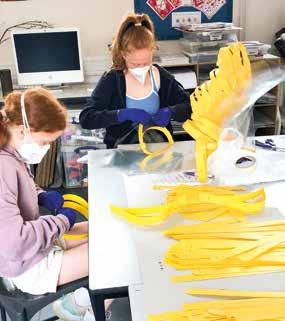
Some remarkably selfless and caring actions should be recorded. Emma McGowan and her four daughters spent much of the Easter Holidays with Head of Design and Technology, Martin Scouse, in the DT room, manufacturing Personal Protective Equipment in the form of face shields on a laser cutter lent by Oakham
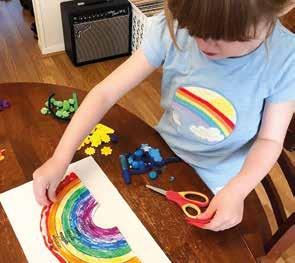
Above: Amelia B (Year 1). Below: Recycled fruit and veg man by Toby (Year 5). Below right: McGowan family bubble production line.
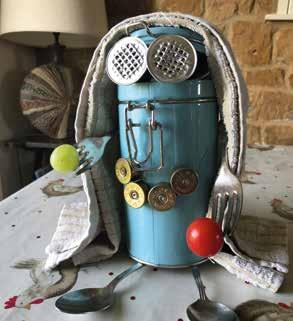
School and then distributing them to care homes, health centres, hospitals and charitable organisations far and wide. School Sister Wendy Bull spent her time on furlough volunteering to nurse the critically ill on the Covid wards of the John Radcliffe Hospital. Words fail to match the admiration she deserves for that and, along with her assistants, for keeping us safe and wellbriefed for the last year. And, needless to say, the buck stops with Emma Goldsmith, who has been a caring and determined leader throughout. This is the kind of crisis which underlines the importance of mutual support for each other’s wellbeing.
This was an intensely stressful period for many staff. The majority of the teaching staff taught remotely, with daily briefings from Emma Goldsmith as Head, on shared calls. We grew used to seeing the interiors of each other’s kitchens and studies and, as summer came on, garden furniture and gazebos! Some, however, owing to the nature of their roles, were obliged to join the Government furlough scheme, which offered a generous proportion of regular salary in exchange for abstinence from turning up for work. Generous though this was, it occasionally led to a feeling of isolation in those on furlough, who were not allowed by the regulations even to join in morning briefings. It was the responsibility of individuals to support them on a personal basis. The same consideration was given to all those with secretarial, maintenance, clerical and domestic roles. No-one was cast adrift.
Eventually, the lockdown lasted far longer than many had feared and has changed the culture of the nation in ways as yet incalculable. Everyone became familiar with new terms such as “lockdown”, “R-number”, “flattening the curve” and most of all the new universal “Covid-19”, a well-chosen non-accusatory name for a disease which would prove entirely diverse in its pandemic coverage.
Unavoidably, school exams were cancelled, though Common Entrance was undertaken under parental supervision in the homes of individual candidates. So many of the delights of the Summer Term were victims: Sports Day, dramatic performances, concerts, iconic cricket and netball fixtures, the Classic Car Show (it was a beautifully warm day, too). A few children were allowed back by easing of the regulations so that the end of term was celebrated in a reduced, socially-distanced and virtual way with prizegiving and commemorative speeches. The memorial service for the life of former Headmaster Richard Speight has been postponed as has the formal launch event for “The House on the Hill”.
This horribly elusive virus at the time only touched WHS briefly with a few suspected cases reported and some periods of self-isolation for individuals, but its potential remains undiminished and indeed resurgent as this account is written. We all returned in person for the start of the new school year under strict cleaning and distancing regimes, but the rapid emergence of the dreaded second wave had to be faced. This account paused on the eve of the second

national lockdown, which lasted for one month; every endeavour was made to keep schools open and healthy. Thanks and respect are due to the perseverance and courage of all who are making this happen, from governors, leadership teams and staff of all positions to parents, carers and, not least, to the children themselves.
Little did we know how comparatively lightly the virus had affected us when the Christmas season approached. Once again, so many communal activities from fireworks to carols, were cancelled; face masks and visors were much more in evidence; tiers and heatmaps became the new vocabulary. On the other hand, hope was rekindled by the approval and rollingout of the Pfizer and Oxford Astra Zeneca vaccines. On Monday January 4th, we were ready to start face-to-face teaching under the same conditions as last term. This time we felt better equipped, with the staff either tested, or booked to be tested, the next morning.
No-one, however, can have been too surprised when, after calls from all sides, the Government put the nation into Lockdown number three, this time closing schools to all but nursery-age children and the children of key workers. In Greek mythology, the name Prometheus means “one who thinks ahead” and the WHS response was typically Promethean. By the time term started for the children on Wednesday 6th January, the teaching was organised on a remote basis on Google Classroom, the timetable was reorganised, the Nursery was ready to receive children and the School site was providing education for the children of key workers.

As we embark on another term of online learning, where children will now have been home educated for two of our three terms, a few adjustments were made: it was felt that the experience of learning would be more authentic if it were now the rule that school uniform be worn during online lessons and that the same rules of staying at one’s place during lessons applied. We are all on a steep learning curve.
Emma Goldsmith put it very aptly when she said at the pre-term remote staff meeting that Winchester House is learning not to fear the storm but to “dance in the rain” – to weather hard times without losing sight of the positive values which the School embodies. And so we all travel down this long tunnel towards the light which we are promised, and which is surely coming. H
Flora (Year 7). Amelia (Year 1).











